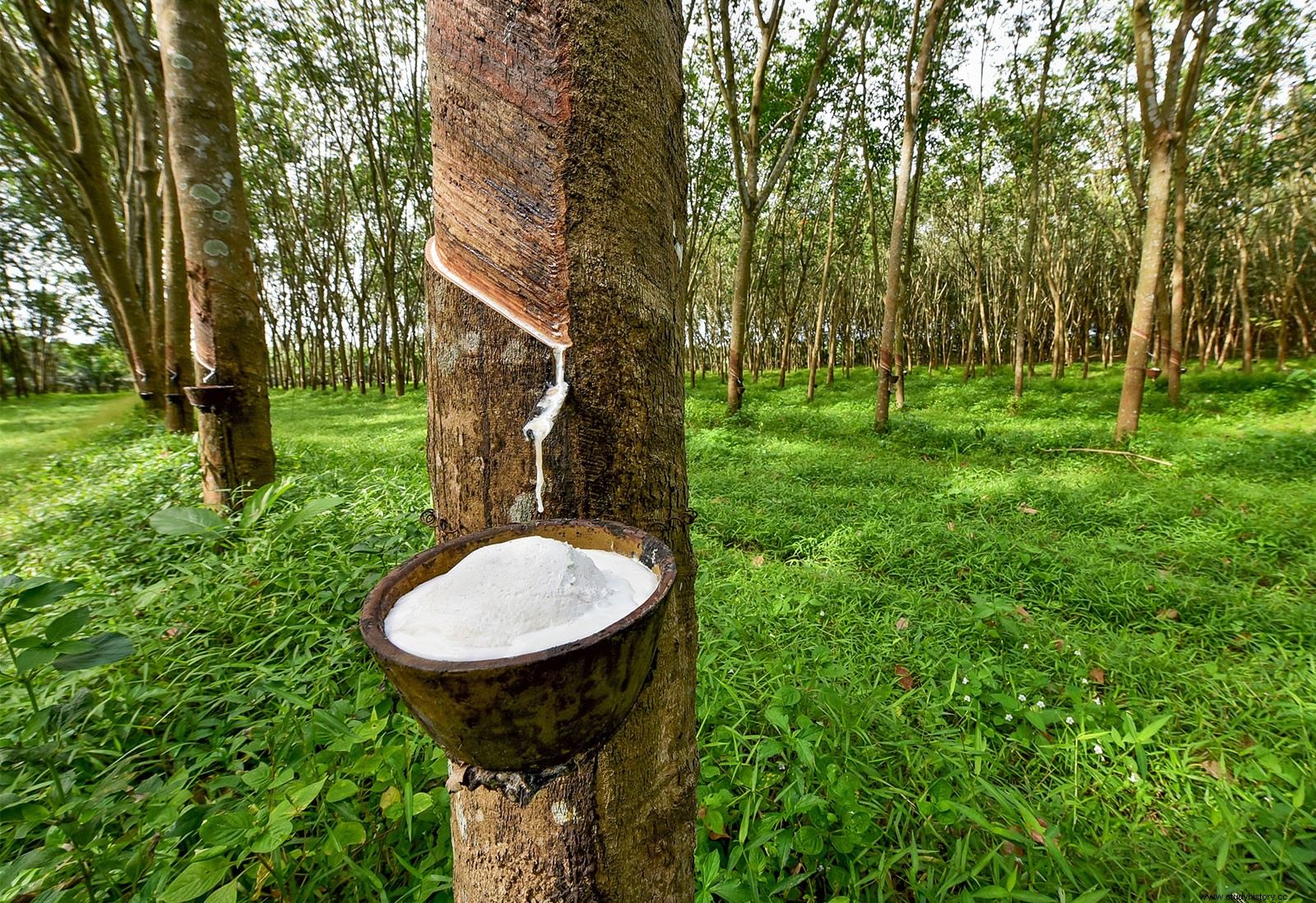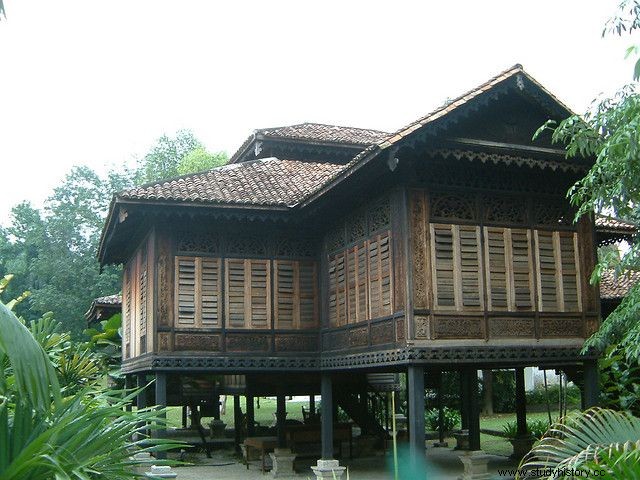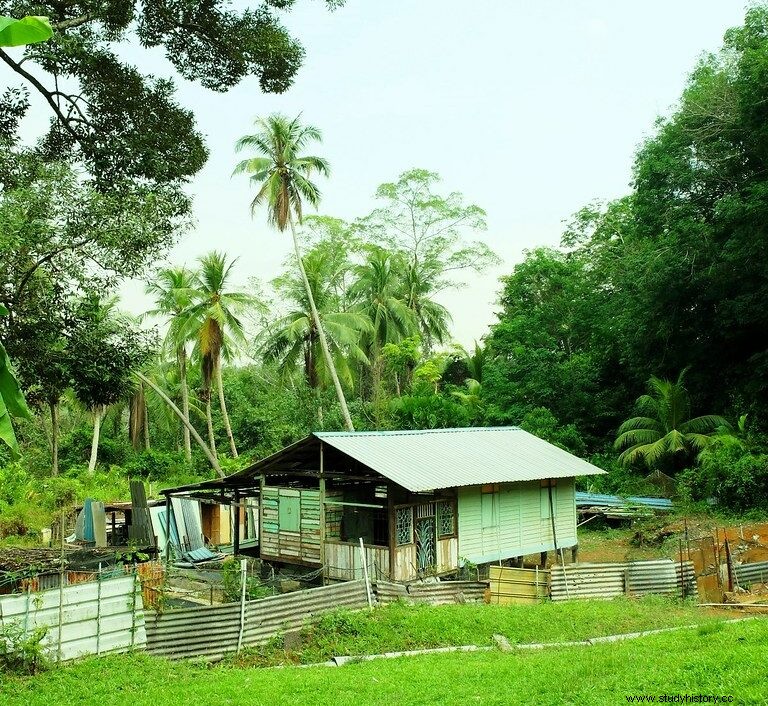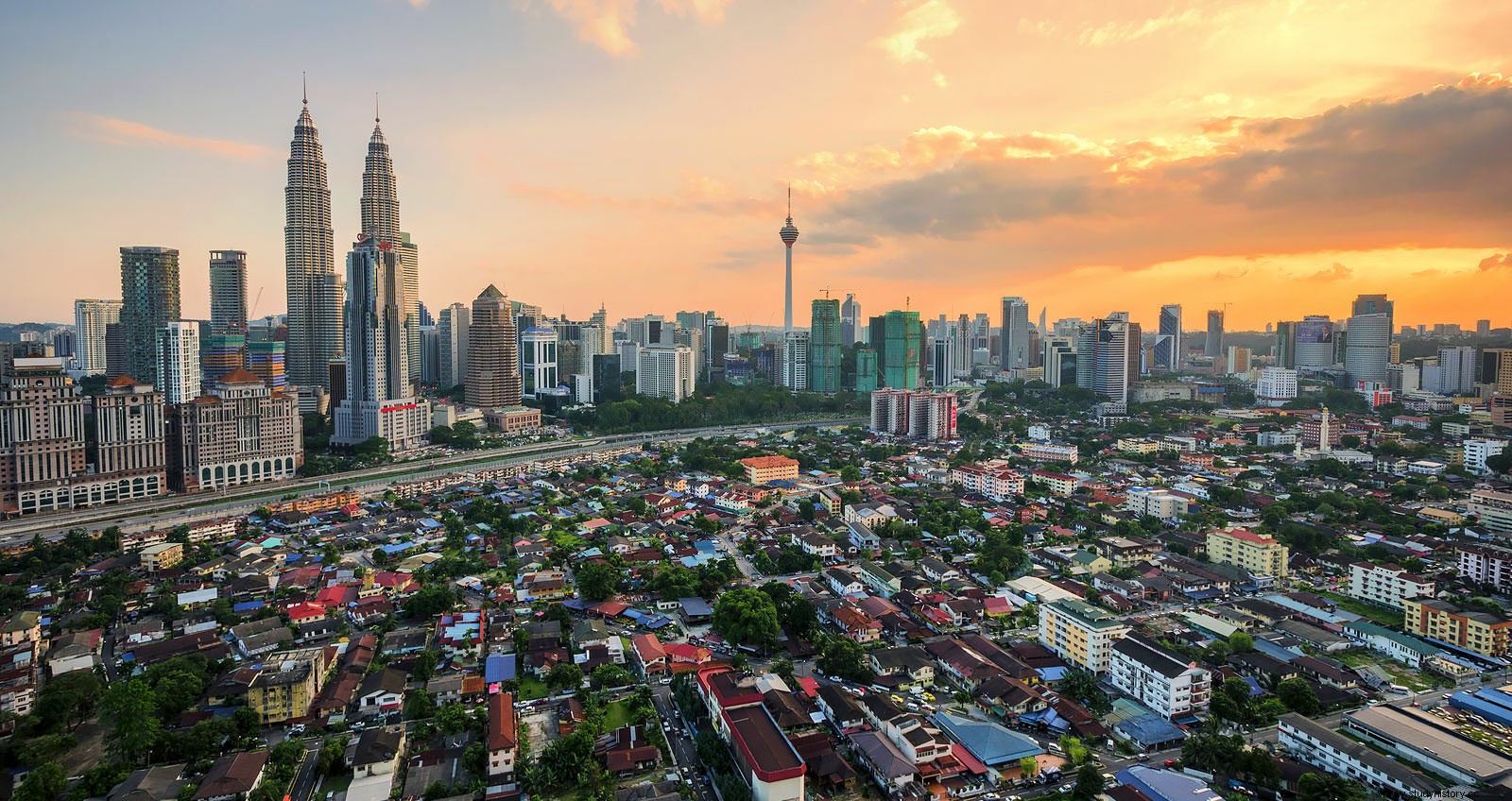When we talk about Singapore and Malaysia, we usually talk about urban areas or places that are popular tourist destinations.
Singapore is generally known for its modern buildings, shops, events and for being technologically advanced.
Malaysia, on the other hand, is not only known for its cities, but also for a diverse variety of physical landscapes and rich heritage.
Speaking of heritage, it's one of the things that Malaysia and Singapore share. They are both home to several multiethnic and multicultural people, as a result of their common history until 1965.
1965 was the year Singapore became an independent state.
Within this shared past lies the term 'Kampong' or 'Kampung' which many of us are not familiar with. It is an important part of the local culture in the two countries and
Kampong is a Malaysian word that translates to "village" in English. They are a type of traditional village or cluster of houses that are normally located near a body of water.
This concept is visible in and around the Malaysian archipelago in Southeast Asia. Therefore, Singapore and Malaysia are not the only countries that are familiar with the idea. Indonesia, Brunei, southern Thailand and even Cambodia have their own campaigns. In Cambodia but the word refers to a place along a body of water and to a river town. The essence of a campaign is the same everywhere, but people and their customs are what sets them apart.
Through extensive research, I found that it was the natives of Malaysia who first inhabited a kampong.
As such, this post will also focus on the concept of kampong in Malaysia and Singapore. Even in this context, there are several types of enclosures as there are also several cultures within this area. Different indigenous tribes have their own kampong style; Chinese-influenced campaigns have their own style; The Peranakan-style campaigns are also different, but since this post aims to briefly explain the idea of campaigns, it will primarily focus on the general indigenous idea and culture of a campaign in these two countries.
What is a Kampong?
The word kampong usually refers to a small village or enclosure with a group of traditional houses that were originally inhabited by the Malays of the indigenous people.
Depending on the location, there would be a rice field on the outskirts of the village, where people would work.
Larger campaigns also exist and have mosques, schools, cemeteries to honor and pray to the ancestors in the afterlife.
The essence of a Kampong
In a campaign, everyone helps each other and they take care of each other. For example, if a household has surplus food, they would share it with the neighbors. To return the service, they would then help them with something else. Acts of selflessness and kindness are what make up the majority of the campaign culture.
Here there is no individual concept, everything is shared between the community. Residents often share daily and additional festivals such as Eid, and ceremonies such as weddings and funerals.
Historically, building houses was a big deal in Kampong culture, and usually the whole village would be involved in the activity to help the new tenants.
Everyone knows each other in these villages, which makes it a safe place where people have each other's backs.
Leadership
Originally, the campaigns were led by a village chief named Penghulu, who also had the authority to resolve civil cases. Some sources mention that this post was inherited, but that the person must also have been someone who had met the following criteria:
a) Had completed the Hajj or pilgrimage to Mecca
b) Had a sufficient amount of wealth
c) Had sufficient wisdom and life experience
But over time, the concept of having a village chief gradually disappears. Instead, there are landlords who charge a small monthly fee for using the land. The plot would be used to build houses and to plant fruit trees and vegetables to support themselves.
Other meanings of Kampong
The European colonists referred to Kampong as a city, a neighborhood, or a connection. In fact, the English word compound, which means an enclosure with a group of buildings, is derived from the Malaysian word kampong.
In Malaysia, a kampong is referred to as a small Malaysian village with less than 10,000 19 ethnic Malaysian people. According to the Sultan of Selangor in the XNUMX century, the Malaysian people refer to people of the Malaysian race who speak the Malaysian language and practice Islam.
Over the years, kampong is also used to the village or place of origin. More recently, it has also been used to describe urban slum areas.
Origin and development
Native Malays or Bumiputera, include the several indigenous tribes in Malaysia. They all moved and settled on the swamps and riverbanks as the lands were more fertile; ideal for agricultural activities. The original Kampong culture is based on myths and beliefs followed by Bumiputera.
They wanted to construct traditional Malaysian houses or Rumah Melayu, which resembled the houses found in today's kampongs. The natives of the Malaysian Peninsula and Borneo wanted to build them with naturally available materials such as wood and bamboo.
Note:Malaysia is divided into West Malaysia, which is the Malaysian Peninsula, and East Malaysia, which is located on the island of Borneo. The two are separated by the South China Sea about 600 km apart.
When the Europeans arrived in the region in the 16th century, they had interacted with the local tribes and learned to obtain valuable resources from the dense forests and swamps. This is how Europeans began to mine precious metals and extract rubber.
By the 18th century, European colonizers in the region had begun extracting tin and other precious metals and extracting rubber. To help with these tasks, Arab, Chinese, and Indian immigrants were brought in as labor. With the influx of immigrants at that time, new areas were established near the trading ports for their accommodation. Over the years, these areas have become modern cities filled with people from different backgrounds.
This concept was new to the native Malays living in Kampongs, which made them reluctant to move to these urban areas. So they decided to live in their quiet and familiar rural areas. This is one of the reasons why the kampong culture is seen as 'backward' and 'antibody'.
Kampong culture explained
Tro
People who live in these villages embrace community and have a strong sense of community. People believe in sharing the common burden of a task. This is known as the kampong spirit.
The villagers also respect each other, especially the elderly. However, they place their faith in God more than anything else.
housing
People believe in spirits and superstitions. This plays an important role when choosing a place to build their house. A local priest would perform rituals to check if the place would be appropriate enough not to disturb the spirits. They believe that if the spirits are disturbed, they will disturb the occupants of the new house and bring them calamity.
Building a house is therefore not planned according to the surroundings and the availability of resources. There are usually 20 to 30 houses in a village, but larger areas can even have 50 houses. The houses have enough space to separate them from each other to the necessary space to plant trees, grow animals and grow crops.
As the villages were normally near water or in swampy areas, dwellings were built on wooden pens.
Rumah Melayu house
As mentioned earlier, this traditional house was made of wood and bamboo built by indigenous people.
Since they did not have nails to fasten the materials together, they would cut recesses on the materials and lock them with the other pieces to join them.
Without fixtures and fittings, it was easy for them to dismantle the building materials, carry them and build new houses in new places. This also supported their original nomadic lifestyle. These types of houses existed long before the arrival of the Europeans, and the same style continued even after their arrival and even after they introduced new materials such as bricks and nails.
The hot and humid weather and location presented several challenges in maintaining the house's structural integrity. They encountered problems with floods, termites, wild animals, heat and even thieves.
To solve all these problems, they came up with an innovative solution:to build their houses on stilts 1-3 meters from ground level. The raised platforms would allow ventilation under the main room, cool the house in the tropical climate and solve the other problems.
architecture
The traditional houses would follow a certain order from the outside to the interior. The order is as follows:
- Anjung:The porch where guests would be received and welcomed into the house.
- Serambi:The porch at the front of the house. This place was used for relaxation and to entertain guests in a room a little away from the main room.
- Rumah Ibu:This refers to the main living room or even the part of the house that is away from the kitchen. This area is divided into smaller rooms called Bilik. Selang:The place between Rumah Ibu and Dapur. This also led to the second staircase of the house.
- Dapur:The part of the house with the kitchen. This would be located at the end of the house, away from Rumah Ibu to avoid the possibility of catching fire. Dapur would not normally have a roof over his head.
The iconic feature of these houses was the gables in the gable style. Just like stilts, the roofs would also allow cross-ventilation and cool down the living space.
Stairs would connect the ground and porch. Sometimes they wanted designs on them. The decorative designs, the aesthetic details and even the structure of the house will depend on the location and what the residents wanted.
These houses had no fences as there was no sense of formality among the people. No one would think that they exceeded their limits, they would just invite themselves into other people's households. The concept of transgression did not exist here, and the people of the village would like to have a giant, loving family.
Jendala or windows were constructed according to the availability of nails.
It is interesting to note that the kampong houses that exist today are a hybrid of the traditional Rumah Melayu and colonial homes. This is either in terms of the architecture, the type of materials used or the construction method.
Lifestyle and diet
The occupation of the villagers will depend on the location. For example, the campsites near the coast or the river would fish. Those with rice fields on the border of the village would work there. Those along the coast and the mangrove swamps would serve as woodcutters and fishermen.
The villagers ate what was locally available to them. Traditionally, the inhabitants of the kampongs grew their own crops and even farmed livestock, for example the kampong chicken. This custom continued, and therefore their diet would consist of seafood, local chicken, rice, organic home-grown vegetables and fruits, traditional biscuits and tea. These are the same foods that are visible in today's Malaysian food.
Kampong houses did not have access to running water, boiling gas or electricity. Paraffin lamps were the light source after dark, and the main fuel was wood.
Originally, hygiene practices were not advanced either. To begin with, the bathing areas and bathrooms were common rooms, used by all. Later, each household got its own toilet in the form of wooden planks. Under these planks a hole was to be dug and a bucket set. One person was instructed to empty these buckets every other day.
For clothes, either rainwater was collected or it was fetched from the local well.
Many families would not be able to afford to send their children to school, so they would spend time doing housework, catching fish or playing traditional games such as chasing a chicken, five rocks and chapteh. Chapteh is a game played with a colorful, weighted feather ball. The spring ball is kicked and sent around to the players using the legs and feet. The goal is to keep it in the air for as long as possible.
Overall, life was relaxed, simple and enjoyable. This attitude to life is still seen among the ethnic Malays.
Wealth
Over time, it became easier to distinguish between the rich and the poor in the neighborhood. The poor wanted to live in attap houses, where the thatched roof was built with the attap palm leaves. The wealthy, on the other hand, wanted to construct the entire house, including the wooden roof.
Folklore
Stories are a form of intangible cultural heritage and Malaysian stories were conveyed verbally. They are often based on indigenous philosophies, supernatural characters based on Malaysian myths, healing rituals and even historical events.
The Ulun-no-Bokun people live in several camps in North Borneo. They have a story about an animal named Magaiyun. This animal has bat-like wings, lives in a cave, barks like a deer and can eat humans. The story is about how the surviving villagers successfully defeated the beast and survived their wrath.
Stories would also be told by a professional storyteller called Penglipur lara from one campaign to another, in public places and even royal courts. He wanted to recite them in the form of melodic poems that are still familiar to the ethnic Malays. These stories were about princes and princesses.
Kampong culture today
Today, the remaining campaigns in Singapore and Malaysia have their own toilets with access to electricity, water and boiling gas.
Today, the fees of the landlord of a campaign are more visible. However, tenants no longer need to build their own houses.
Citizens today also appreciate more privacy, and they believe in infringement, unlike their ancestors.
Campaigns have been victims of urbanization for the past 40 years. In Singapore, the government sponsored the relocation of villagers to urban areas to develop rural areas in the 1970s. Therefore, there are only 2 active campaigns left in Singapore.
This weakened the kampong lifestyle and led to a sudden lifestyle change for those who previously lived in villages. While they took the time to adapt to the urban lifestyle from their relatively primitive; the people who already lived in these areas began to associate their habits with being undisciplined and uncivilized in urban contexts. Their natural lifestyle was unfavorable in urban Malaysian and Singaporean spaces. As such, there is another reason why the word Kampong is seen as urban anti-urban.
In Malaysia, a quarter of the population still lives in Kampongs, in rural areas.
Relevant places to visit
If you want to experience and feel the atmosphere in how these traditional villages can be. I highly recommend the following places to visit.
Please note that some of these places are not meant to be tourist attractions. These campaigns are still active with people living in their own homes. So in some of these areas it is only to get the atmosphere of the place and enjoy the atmosphere, while in some it is also possible to get involved with the residents.
Singapore
Pulau Ubin, Singapore:An island 15 minutes from mainland Singapore. This island houses some of the fishing campaigns. It is even possible to go into one of the houses and see how a traditional kampong house feels. Bumboats are available from Changi 3 SGD Ferry Terminal.
Kampong Lorong Buangkok, Singapore:Located on the northeast side of Singapore. This is a kampong established in 1956, where a mixture of Chinese and Malaysian populations live together. It is the last active Kampong left on the main island of Singapore.
Kampong Glam, Singapore:Home to the Sultan of Johore in the 19th century and a community of Arabs and Muslims from different communities from present day Indonesia. At that time, it housed shop buildings that were both shops and homes for the locals. These department stores have now been converted into commercial outlets, cafes and ethnic restaurants. Sultan Mosque and Malay Heritage Center are also located in this area.
Malaysia
Kampong Bharu, Kuala Lumpur:The traditional Malaysian houses in this urban kampong were established in 1899 and feature classic Malaysian elements along with some colonial architectural elements. The hybrid houses were built by local builders with the owner's vision in mind.
Sarawak, Borneo:Visit this state on the island of Borneo in eastern Malaysia and live in the ethnic houses of the many tribes living in the country. Engage and interact with the locals and their culture. For more information, visit the official website of Sarawak Cultural Village.
Both Singapore and Malaysia are popular destinations not only in Southeast Asia but also in the world. Kampong life is not something tourists usually come across in these two places, so it can be hard to believe that such a culture and lifestyle exists, and that it is so deeply ingrained in the locals, especially the ethnic Malays. As tourists, it is therefore important to sometimes look beyond the ordinary in order to really understand the places we visit.
Do not hesitate to share your thoughts on this post in the comments section and click here. for more articles like this.
Bibliography
Al Jazeera, 2013. Al Jazeera. [Online]
Available at:https://www.aljazeera.com/news/2013/5/1/timeline-malaysias-history
[Visited March 21, 2021].
Bunnell, T., 2002. Kampung Rules:Landscape and the Contested Government of Urban (e) Malayness. Urban Studies, 39 (9), pp. 1685-1701.
Hays, J., 2015. Facts and details. [Online]
Available at:http://factsanddetails.com/southeast-asia/Malaysia/sub5_4b/entry-3651.html
[Visited March 22, 2021].
Ju, SR, Kim, BM &Ariffin, SI, 2015. Continuation and transformation of traditional elements in colonial vernacular houses in Kampong Bharu, Malaysia. Journal of Asian Architecture and Building Engineering, 14 (2), pp. 339-346.
Keith, H., 1936. ULUN-NO-BOKUN (MURUT) FOLKLORE. Journal of the Malayan Branch of the Royal Asiatic Society, 14 (3), pp. 323-326.
Kong, L. &Law, L., 2010. Introduction:Contested Landscapes, Asian Cities. Urban Studies, 39 (9), pp. 1503-1512.
Lambert, T., 2020. Local Stories. [Online]
Available at:http://www.localhistories.org/malaysia.html
[Visited March 21, 2021].
Lockard, C., 1987. From Kampung to City:A Social History of Kuching Malaysia 1820-1970. 1 ed. Athens, Ohio:Ohio University Press.
Loo, DYM, 2013. Architecture and urban form in Kuala Lumpur:Race and Chinese spaces in a postcolonial city. 1 ed. Farnham:Ashgate Publishing, Ltd.
Moore, WK, 1995. This is Malaysia. 1 ed. Cape Town:New Holland Publishers Ltd.
NASIR, MRBM, 2011. A STUDY OF KELANTAN MALAY CULTURAL LANDSCAPE:NEW TRENDS AND FUTURE PROSPECTS. University of Sheffield Department of Landscape, pp. 1-201.
OdM, A., Zakaria, Z. &Hashim, WAF b. W., 2016. Nusantara:Delineating Its authentic map based on indigenous sources. Intellectual Property Rights:Open Access, 4 (2), pp. 1-4.
Redmondmom, nd Singapore Cuisine History - What is a Kampong ?. [Online]
Available at:https://redmondmom.com/auntie-belacan-history/singapore-cuisine-history/
[Visited March 21, 2021].
Remember Singapore, 2012. Remember Singapore. [Online]
Available at:https://remembersingapore.org/2012/04/04/from-villages-to-flats-part-1/
[Visited March 21, 2021].
Tajudeen, I. b., 2012. Singapore Stories. [Online]
Available at:http://singapurastories.com/kampungcompound-houses/kampungcampongcompound/
[Visited March 22, 2021].
Ujang, N., 2016. CHANGES THE HISTORICAL URBAN CITY OF KAMPUNG BHARU TO A NEW CITY CENTER IN KUALA LUMPUR. Malaysia Sustainable Cities Program, Working Paper Series, pp. 1-19.









